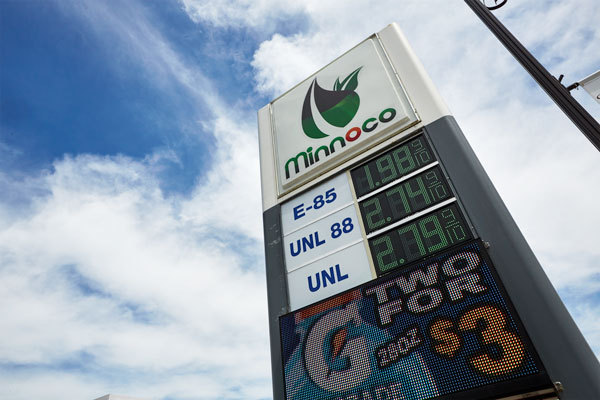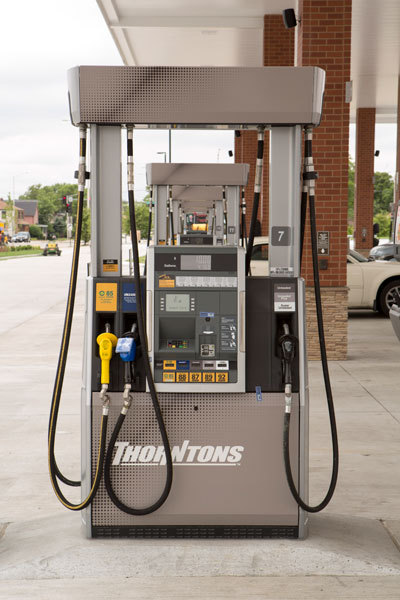The Quest to Stop E15's Summertime Shutdown




PHOTO: THORNTONS
February 17, 2022
BY Tom Bryan
Ten days into 2022, the U.S. Supreme Court gave notice that it would not review the D.C. Circuit Court of Appeals mid-2021 ruling that—starting June 1—will again prohibit year-round E15 sales across large swaths of the country. The high court’s rejection made it clear that a quick legal resolution to ethanol’s most vexing domestic growth challenge is off the table.
Emily Skor, CEO of Growth Energy, which led the petition, was among the first industry leaders to acknowledge that securing summertime E15 will now likely need to be accomplished through regulatory or legislative means. After the court’s rejection, she said, “Growth Energy will continue to explore all potential avenues to make unfettered access to E15 a reality.”
Brian Jennings, CEO of the American Coalition for Ethanol, says the outcome of Growth’s petition was not altogether predictable.
“It was a longshot, yes,” he says. “But just last year, the court took up the small refinery exemption decision from the 10th Circuit Court. So they had shown interest, and I don’t think they rejected this latest petition on the substance of the issue. It’s just the nature of the beast.”
Jennings says the high court’s decision to not enter the E15 fray closes the legal door for uninterrupted E15. But the rejection also gives clarity to what the industry needs to do. “Our collective efforts need to be squarely focused on the regulatory and legislative options at our disposal,” he says.
Legislative Fix
The most complete solution for regaining clearance for year-round E15 use is federal legislation. Last summer, after the appeals court struck down the Trump administration’s 2019 rule that lifted restrictions on summertime E15, bipartisan legislation was introduced in both houses of Congress that would allow retailers to sell E15 and higher ethanol blends year-round. Months later, ethanol trade groups still agree that a legislative fix to the issue remains ideal, but only if it doesn’t attract anti-biofuel meddlers that try to inject ride-along legislation that could compromise the renewable fuel standard (RFS) or the Clean Air Act.
Renewable Fuels Association President and CEO Geoff Cooper told Ethanol Producer Magazine in January that a legislative approach to resolving the E15 problem is plausible but risky. “There have been bills reintroduced in Congress that could fix this issue once and for all,” he said. “But the odds of getting that type of legislation across the finish line in the near term, without opening the door to mischief on the RFS and other priorities we care about, are low.”
Jennings agrees but says the costs of not finding a solution to the E15 issue outweigh the risks. “There is such a tremendous sense of urgency around trying to make sure we have uninterrupted access to E15 that we really can’t take a single option off the table,” he says.
Chris Bliley, Growth Energy’s senior vice president of regulatory affairs, says the most appealing thing about having Congress restore uninterrupted access to E15 is that it would be a blanket solution for the entire country. “A nationwide fix that takes care of this whole issue in one move would be ideal,” he says. “The legislation that’s already been introduced would resolve this for good—it would restore what EPA established in 2019.
Getting Congress to act on E15 would be “an incredibly heavy lift,” Jennings says, and it is implausible that a stand-alone bill would survive. “We’d have to find a way to hitch a ride on another piece of must-pass legislation” he says.
Jennings continues, “I agree that the cleanest way to fix this problem, once and for all, is for Congress to clarify the statute bill and make clear that any blend above E10 receives the 1-pound waiver. Then, we wouldn’t have to worry about the politics of the EPA, how the agency might interpret the Clean Air Act, or how a court might settle this. If Congress were to definitively act, it would be the cleanest and best solution. But, again, getting that done would be incredibly difficult.”
Regulatory Routes
In November, a group of governors from eight Midwest states sent letters to EPA Administrator Michael Regan seeking guidance from the agency on how to pursue a little-known provision of the CAA that could allow states to independently allow year-round E15.
Specifically, the governors asked the EPA for clarification on Section 211(h)(5) of the CAA, which establishes that, upon request from a governor, the agency can apply volatility limitations to gasoline-ethanol blends that exclude the benefit of the 1-pound per square inch (psi) Reid vapor pressure (RVP) waiver provided to E10 by the CAA. “If approved,” the letter states, “it is our understanding that such a request would result in a volatility limitation of 9 psi for both E10 and E15 in conventional gasoline areas, thereby establishing a level playing field and allowing retailers to use the same gasoline blendstock for both blends all year long.”
The letter goes on to explain that the governors have not actually submitted the notification required, but are simply expressing interest in pursuing the approach and asking for guidance. “We would like to open a dialogue with the agency on this issue and we are respectfully requesting your guidance regarding the process for securing an exclusion from the [1-pound waiver],” they wrote.
More than 120 days later, the timeframe for action is intensifying, and EPA has not responded. Meanwhile, industry trade groups, growingly impatient with the agency’s inaction, are pressing EPA to use its legal authority to eradicate the RVP barrier straight away.
“From what I understand, EPA has still not responded to the governors,” Jennings says, adding that the request for guidance came from a bipartisan group. “Both Republicans and Democrats are asking for this, which you think would compel the Biden administration to respond.”
The governors, if and when they are told how to proceed, will likely petition the EPA to allow their state to opt out of the 1-pound waiver for E10. “Practically speaking, that would prompt refiners to supply a lower volatility blendstock for both E10 and E15, so it would be a way to avoid the waiver altogether,” Jennings says, adding that the eight governors, or an even larger consortium, could petition EPA simultaneously to prompt the agency to act. “Hypothetically, EPA would have to consider that and probably draft a proposed rule to effectively move forward with the request from those governors. There would be a comment period and eventually a final rule. It would take time, but it’s one way to do this.”
EPA Could Act Independently
The swiftest regulatory modification of E15’s summertime dilemma is for EPA to take action on its own.
In December, six national farm and biofuel organizations including Growth Energy and RFA asked EPA to enact regulations requiring lower-volatility conventional gasoline blendstock in the summer.
“We have been looking at whether EPA could simply step in and do that” Bliley says. “If EPA lowered the vapor pressure of the BOB (blendstock for oxygenated biofuel) in conventional areas—if they brought that baseline gasoline [RVP] down—it would be a national solution for all areas where E15 is blocked out in the summer.”
As it did under Trump, Jennings says, EPA could levy a new rulemaking allowing states to opt out of the RVP waiver. “In 2019, they looked at the Clean Air Act and found a way to extend the 1-pound waiver to E15,” he says. “In the same way, knowing that the court has already invalidated that option, Biden’s EPA could propose a new rule for a reduced volatility gasoline for E10 and E15 alike. EPA doesn’t have to sit on its hands and wait for petitions. The agency can act now, on its own.”
Under previous and current regulations, E15 is prohibited from retail sale from June 1 through September 15 in areas of the country where conventional gasoline is sold. In principle, this is done to prevent fuels with a 9-pound-psi RVP or greater from turning to vapor and contributing to smog. Neither E10 nor E15 meets the strict summer standard but the CAA made an exception for 10% blends over 30 years ago. E15 didn’t exist commercially at the time and, hence, was not given the same treatment. That is, until 2019, when EPA decided that E10 and E15 were similar enough for both blends to get the waiver. Two years later, the courts ruled on the side of Big Oil, reversed the rule, and reinstated E15’s summertime restriction.
Even though the Trump administration made summertime E15 possible throughout the nation in June 2019, the industry’s effort to leverage year-round access to grow the fuel’s retail presence didn’t begin in earnest until 2020—just as Covid emerged. “And given how difficult 2020 was, I’d have to say 2021 was really the first near-normal year for uninterrupted, nationwide E15, even with the unfavorable court ruling in July,” Bliley says, explaining that the number of E15 retail stations in the U.S. was expected to grow from 2,500 to more than 10,000 by 2024 without the summertime ban in place. “But we just haven’t had an extended period of time with year-round RVP relief to see what it can really do.”
Some Markets Unaffected
With just a few months remaining for a solution to emerge, the ethanol industry is growingly resigned to the fact that 2022 may be a summer without E15 in many parts of the country. The ban does not affect the entire nation, however. Bliley explains that areas of the U.S. that have previously opted out of the 1-pound RVP waiver will continue to sell E15 this summer. “In metropolitan areas like New York, Chicago, Houston, Dallas and other places, you’ll continue to see E15 in the summer,” he says, explaining that population-dense areas of the country that have historically had issues with urban emissions control in warm weather months have opted out of the E10 RVP waiver and use reformulated gasoline (RFG) that has an RVP of about 7.4 pounds psi, allowing both E10 and E15 to maintain year-round RVP compliance. “But for areas like Iowa, Minnesota, the Dakotas, North Carolina, Tennessee and other parts of the country where conventional gasoline is used, E10 gets that 1-pound RVP waiver and E15 doesn’t.”
Jennings remains hopeful that an answer can be found soon. “If by some chance we are able to enact legislation between now and June, maybe that would allow for uninterrupted access to E15 in the marketplace,” he says. “I think, practically speaking, whether the EPA were to take a new regulatory approach to fix this on its own, or they were petitioned by Midwest states to take a regulatory approach, there’s a process they are going to have to follow and it’s a process that’s unlikely to be complete by June 1.”
In the meantime, Jennings says, EPA needs to be reminded that E15 is a proven fuel that is compatible with a quarter of a billion vehicles on the road. “Perhaps an argument can be made that, if there is a proposed rule and a comment period gets underway, that E15 could remain on the market,” he says. “Because this is undoubtedly going to be time consuming.”
Jennings says it is also unclear how EPA will enforce E15’s prohibition in the summer. “I really don’t know how the agency is going to enforce this,” he says. “If a solution isn’t in place by June, I’m pretty sure EPA isn’t going to send out enforcement officials to every gas station across half the country.”
Bliley agrees that it’s unlikely EPA has the ability to fully enforce E15 restrictions this summer, but also unlikely that major retailers would risk violating regulations. “The bottom line is that we need to get this resolved so there isn’t any uncertainty out there,” he says. “I think the retailers are unlikely to take any risk. They want consistency with E15, and we need to figure it out.”
Bliley says Growth Energy plans to continue pushing hard on all viable regulatory and legislative solutions. “I don’t think we can afford to ignore any possible solution,” he says. “It’s important that we get something in place that works for everyone. We appreciate what the governors are doing; we appreciate what our friends in Congress are trying to do; and we’re also going to keep pushing EPA on what they might be able to do. We’re staying active on all paths. It’s that critical.”
A Numbers Game
In addition to the industry’s E15 dilemma, its other lanes for domestic growth—E85 and mid-level blends—may be impeded in the next decade as existing flex-fuel vehicles (FFVs) age out over time while automakers, lacking incentives, produce fewer of them. The RFA recently reported that just 11 FFV models from two automakers are available this year, compared to more than 80 models from eight manufacturers half a decade ago.
Jennings says lower FFV production coupled with the reinstated summertime ban on E15, creates an extraordinary sense of urgency for marketplace action. “We need additional avenues or additional markets for our fuel,” he says. “FFV’s are very important but E15 is a top priority because virtually every car on the road today is approved to use it—97% of them.”
Despite the slowdown in FFV production, Bliley says, there are still more than 20 million E85-compatible vehicles on the road today. “FFVs are a tremendous benefit to higher blends,” he says, “but there are 245 million vehicles on the road that can use E15. That’s the thing. That’s why we’re fighting so hard get this right.”
Author: Tom Bryan
Contact: editor@bbiinternational.com
Advertisement
Advertisement
Advertisement
Advertisement
Related Stories
CARB on June 27 announced amendments to the state’s LCFS regulations will take effect beginning on July 1. The amended regulations were approved by the agency in November 2024, but implementation was delayed due to regulatory clarity issues.
SAF Magazine and the Commercial Aviation Alternative Fuels Initiative announced the preliminary agenda for the North American SAF Conference and Expo, being held Sept. 22-24 at the Minneapolis Convention Center in Minneapolis, Minnesota.
Saipem has been awarded an EPC contract by Enilive for the expansion of the company’s biorefinery in Porto Marghera, near Venice. The project will boost total nameplate capacity and enable the production of SAF.
Global digital shipbuilder Incat Crowther announced on June 11 the company has been commissioned by Los Angeles operator Catalina Express to design a new low-emission, renewable diesel-powered passenger ferry.
International Air Transport Association has announced the release of the Sustainable Aviation Fuel (SAF) Matchmaker platform, to facilitate SAF procurement between airlines and SAF producers by matching requests for SAF supply with offers.
Upcoming Events










